99th Evacuation Hospital Unit History
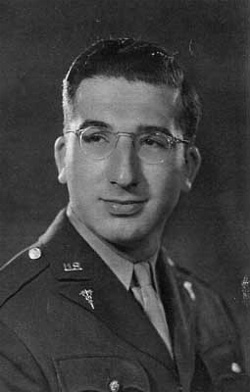
Portrait of Captain Raymond C. Waisman, MC, O-496170, Commanding Officer of the 99th Evacuation Hospital. He replaced Major Robert H. Simpson, 4 February 1946, while the organization served on Honshu, Japan.
Introduction & Activation:
The unit was originally organized as the 11th Surgical Hospital and activated at Camp Shelbv, Hattiesburg, Mississippi (Division Camp, total acreage 83,561, troop capacity 3,999 Officers and 84,058 Enlisted Men –ed), 5 August 1942 (with original cadre from the 74th Surgical Hospital, Fort Francis E. Warren, Cheyenne, Wyoming, Army Service Forces Training Center –ed), under reference Paragraph 7, General Order No. 85, Headquarters, Third United States Army, dated 5 August 1942.
The 11th Surgical Hospital was re-designated the 99th Evacuation Hospital, Motorized (400-bed capacity), 14 August 1942, as per Letter, War Department, Adjutant General Office 320.2, Subject: Re-designation of Surgical Hospitals as Evacuation Hospitals, Motorized, dated 14 August 1942, and amended by Letter War Department, Adjutant General Office 320.2, dated 25 August 1942. The organization was based on the new T/O & E 8-581, dated 8 January 1943, superceding T/O & E 8-581, dated 2 July 1942, and on 24 February 1943 was officially designated 99th Evacuation Hospital. Original personnel strength at the time consisted of 58 Officers and 213 Enlisted Men (figures at 1 January 1944).
Organization:
The following changes in organization took place mid-1943, when T/O & E 8-581, dated 8 January 1943, was amended to a new issue dated 26 July 1943 (involving only medical equipment changes), the hospital now being designated Semimobile in lieu of Motorized.
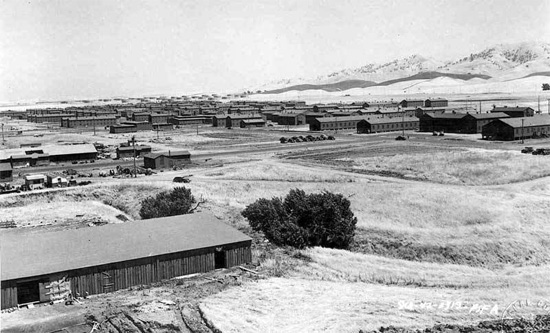
1942. General view of Camp Stoneman, Pittsburg, California. Starting 25 May 1942 the camp became one of the leading staging areas for units moving to the Pacific battlefields. Troops left Camp Stoneman by ferry at the Pitssburg waterfront for piers 15 and 45 where they boarded the ships heading for war. Camp Stoneman had numerous training facilities including: abandon ship training decks – bayonet course – bivouac and road march areas – dry land ship facilities – rifle range – grenade throwing range – rocket launcher range – gas chamber – infiltration course – obstacle course – mock village and a large training film library.
Comparison unit strength Surgical Hospital vs. Evacuation Hospital:
| Surgical Hospital T/O 8-570, 1 April 1942 50 Officers 60 Nurses 275 Enlisted Men |
Evacuation Hospital, Motorized T/O 8-581, 2 July 1942 39 Officers + 1 Warrant Officer 48 Nurses 248 Enlisted Men |
Evolution of Evacuation Hospital strength:
Evacuation Hospital, Semimobile
T/O 8-581, 25 March 1944
38 Officers + 1 Warrant Officer
40 Nurses
217 Enlisted Men
On 22 July 1944, Officers and Enlisted personnel were assigned in accordance with T/O & E 8-581, dated 25 March 1944, as per instructions received by Letter, Headquarters, United States Army Forces in the Far East (USAFFE), File FEGC 322, dated 21 May 1944 and Letter, Headquarters, Sixth United States Army, Office of the Commanding General, APO 442, dated 16 July 1944, Subject: Re-organization of Unit under latest T/O & E.
Surplus personnel was to be absorbed by normal attrition. No EM was to be reduced in grade as a result from this action. Surplus equipment was to be returned to the appropriate supply agencies, and any shortages of personnel and equipment were to be requisitioned in the normal manner.

Aerial view of Hollandia, Dutch New Guinea. At the time, most of western New Guinea was still occupied by Japanese Forces. An amphibious assault by “Reckless Task Force”, involving the 24th and 41st Infantry Divisions, successfully took place place on 22 April 1944.
Total unit strength as of 31 December 1944 was 30 Officers and 194 Enlisted Men.
Commanding Officers – 99th Evacuation Hospital
Captain Claude C. CURTIS, MC, O-381361 > 20 August 1942 – 13 September 1942
Major James M. SMITH, MC > 13 September 1942 – 12 February 1943
Lt. Colonel Clifford G. BLITCH, MC, O-19302 > 12 February 1943 – 19 February 1943
Colonel Clifford G. BLITCH, MC, O-19302 > 19 February 1943 – 15 December 1945
Major Robert H. SIMPSON, MC, O-1699875 > 16 December 1945 – 3 February 1946
Captain Raymond C. WAISMAN, MC, O-496170 > 4 February 1946 – 8 February 1946
Captain Henry E. STEADMAN, MC, O-477159 > 9 February 1946 – 28 February 1946
Movements in the Zone of Interior:
The 99th Evac changed stations several times while serving in the Zone of Interior, continental United States.
The unit was transferred to Camp Cooke, Oceano, California (Division Camp, total acreage 88,803, troop capacity 2,346 Officers and 35,288 Enlisted Men –ed), where it remained stationed from 3 March 1944 to 2 June 1944.
It then moved to Camp Stoneman, Pittsburg, California (Staging Area for San Francisco P/E, total acreage 3,242, troop capacity 2,604 Officers and 35,607 Enlisted Men -ed), where it was stationed from 3 June 1944 to 15 June 1944.
Preparation for Overseas Movement:
By order of the War Department, the 99th Evac Hosp was assigned to the Pacific Theater of Operations, departing for Hollandia, Dutch New Guinea 15 June 1944.
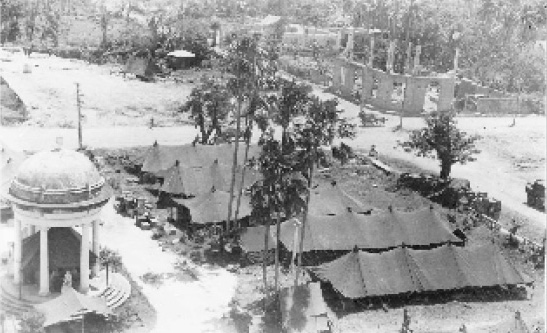
99th Evacuation Hospital operations in the plaza at Molo, Panay, Philippine Islands. Apparently taken from the damaged bell tower of Santa Ana’s Catholic Church between July 31 and September 9, 1945. (First Sergeant Elmer R. Young collection).
Overseas Service:
New Guinea
With Rabaul (New Britain -ed) neutralized, the conquest of the Japanese-occupied western part of New Guinea moved into high gear. General D. MacArthur planned a surprise assault against Hollandia on 22 April 1944, which had the advantage of possessing harbors and airfields. Two Infantry Divisions were chosen for the attack: the 24th Infantry (organic medical unit; 24th Medical Battalion) and the 41st Infantry Division (organic medical unit; 116th Medical Battalion), under the overall command of Lt. General Robert L. Eichelberger, CG, I Corps. Amphibious landings were to take place in Humboldt Bay and Tanahmerah Bay with the major objective being Lake Sentani which held 3 airfields. Medical support for both treatment and evacuation would be provided by a number of LST-H (LST vessels converted into floating hospitals -ed). The respective Infantry Divisions’ Medical Battalions, would further be supplemented by two (2) Portable Surgical Hospitals, 1 Medical Clearing Company (Separate), Company B of the 262d Amphibious Medical Battalion, and the 36th Evacuation Hospital, eventually followed by the 92d Evacuation Hospital.
The next move consisted in seizing Ataipe with the help of the 32d Infantry Division (organic medical unit; 107th Medical Battalion), supported by one (1) Portable Surgical Hospital and one (1) Medical Clearing Station. A 200-bed section of the 54th Evacuation Hospital was also put at the disposal of the TF. Above units were furthermore supplemented by one (1) Malaria Survey Unit, one (1) Malaria Control Unit, elements of the 607th Medical Clearing Company, and personnel of the 30th Evacuation Hospital. As fighting grew more severe the 122d Cavalry Regiment was detached to augment the 32d Infantry Division, and during July 1944, the 5th Portable Surgical Hospital was sent in for additional medical support.
On 15 May 1944 a TF built around the 163d Regimental Combat Team (41st Infantry Division) attacked Wakde and Sarmi. Medical support was provided by the 2d Portable Surgical Hospital and the 54th Evacuation Hospital. Reinforcements were brought in consisting of the 11th Portable Surgical Hospital, the 37th Field Hospital, and later the 106th Medical Battalion (organic unit of the 33d Infantry Division). Biak Island was assaulted on 27 May 1944 by a TF comprising the 162d and 186th RCTs. During the fighting casualties were usually evacuated to the 92d Evacuation Hospital, set up at Bosnek and on Owi Island. With Biak in American hands it was now time to move against Noemfoor Island . The attack took place on 2 July 1944 with elements of the 158th Infantry Regiment (Separate), later augmented by the 503d Parachute Infantry Regiment.
The new Hospital arrived at Hollandia, Dutch New Guinea, 16 July 1944. The 99th Evacuation Hospital would remain operational in Hollandia until 13 September 1944. On 20 August, the organization was attached to XI Corps, by General Orders No. 133, Headquarters, Sixth United States Army, Paragraph 6, dated 21 August 1944. The reason for the New Guinea Campaign was to eliminate Japanese forces from the area and provide safe staging areas for further operations against Japan in the Pacific. On 30 August 1944, US forces landed unopposed on the Vogelkop Peninsula, which signified the end for the Japanese as they had no means to supply or reinforce their troops which eventually fled into the hills.
Netherlands East Indies
Morotai Island was assaulted on 15 September 1944 and secured by troops of the 31st Infantry Division (organic medical unit; 106th Medical Battalion) after some heavy fighting on 4 October.
The purpose of the Morotai Campaign was to render the nearby island of Halmahera ineffective to the enemy, to provide a base for air operations against Celebes, Borneo, and the Philippines, and to provide a staging area for the Invasion of the Philippines.
On 14 September, the 99th Evacuation Hospital departed “White Beach 3”, Hollandia for Morotai Island, Netherlands East Indies, on board LST 667 (Operation “Interlude”) in two echelons as part of the “Tradewind Task Force”. The advance party (forward echelon), consisted of 35 Officers, 187 EM, 11 2 ½-ton cargo trucks, 1 ¾-ton weapon carrier, 2 ¼-ton trucks, 1 750-gal water tank trailer, 1 mobile refrigerator, and all necessary equipment supplies plus a 15-day supply of expendables and field rations. This echelon arrived on 19 September at Morotai and settled in a bivouac area to await orders, while the rear echelon comprising 2 MAC Officers, 18 EM, 4 2 ½-ton cargo trucks, 1 ¾-ton weapon carrier, 1 ¼-ton truck, 1 mobile disinfestor, and an extra 15-day supply of expendables and rations only landed on 30 September. The LST remained at anchor in Humboldt Bay. The 99th Evacuation Hospital became fully operational 30 September 1944 with 180 out of 400 beds available (though outpatient service already started 28 September –ed). After setting up 2 operating rooms and 2 ward tents, followed by more ward tents, unit telephone and electricity lines were installed, followed by even more tents. As soon as the mess hall was ready, Officers and men of the 82d and 155th Station Hospitals were messed together (240 Officers & EM –ed), and the rear echelon which had meanwhile arrived moved in.
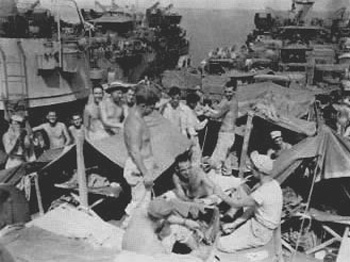
14 September 1944. 99th Evacuation Hospital personnel and equipment traveling on LST 667 bound for Morotai Island, Netherlands East Indies, and part of “Tradewind Task Force”.
14 September > 18 September 1944 – usual ship duties, including providing general medical services.
19 September 1944 – the convoy arrived at 0700 in the Halmaheras at Morati and settled in a bivouac area at 1700 in order to await its assignment of area. First air raid alerts started at 2030.
20 September > 23 September 1944 – usual camp duties, with frequent daily air alerts (up to 2 per day).
24 September 1944 – usual camp duties, Captain Garth L. Pybas, ChC, O-505828, Chaplain, held his first religious service. Two more air alerts.
25 September 1944 – usual camp duties, Colonel Patterson, XI Corps Surgeon, issued instructions for the organization to set up the hospital 400 yards from the bivouac area in the original Headquarters’ site. Another air alert took place.
26 September > 30 September 1944 – usual camp duties, with another air alert. Clearing of the area for the installations continued throughout the period, with the first tent being pitched in the afternoon. CO tent, headquarters tent, receiving, shock, laboratory, x-ray, EENT, dental, property exchange, and four wards set up. Two operating rooms and two more wards followed. Unit telephone and electricity lines available in already existing sections. A second, third, and fourth air alert were given with a single air raid taking place. Inspection of work in progress by CO.
30 September 1944 – work continued in the general area, with mess set up and first meal (supper) served. Two patients received, first operation. More air alerts and enemy raids. Official opening of 99th Evacuation Hospital.
1 October 1944 – work continued in general area, and Officers’ mess opened. Patient census 15. Four air raid alerts.
2 October 1944 – work continued, three more wards were erected, and the Officers’ conference tent was pitched. Available bed capacity 180 and patient census 46.
3 October 1944 – work continued, with the patients’ mess being completed. The hospital road was finalized. Patient census 72. Frequent air alerts.
4 October 1944 – work continued. A first death occurred; S/Sgt. John E. Monti, ASN 334305098, 370th Bomb Squadron, 307th Bombardment Group, Thirteenth United States Army Air Force. The first “Purple Heart” was awarded by the CO to Pvt. Robert Bigelow, ASN 36150422, 389th Antiaircraft Artillery (Automatic Weapons) Battalion (Semimobile) for wounds received in action at Morotai Island, Netherlands East Indies. More air alerts.
By 4 October 1944, bed status was 200, and 89 patients had been admitted. All personnel including the patients had adequate foxhole facilities for protection. Frequent enemy night air raids were common, but did not cause any damage or personal losses to the immediate area. One new malaria case, but no dengue, and no typhus cases were diagnosed during this action. There was no action against or contact with the enemy except in frequent night air raids that however did no real damage.
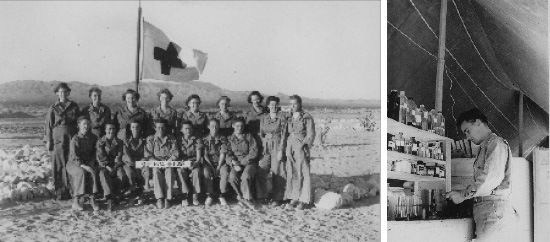
Left: Nursing staff of the 99th Evacuation Hospital.
Right: A technician preparing a prescription in the unit’s Pharmacy.
(Both images from the collection of First Sergeant Elmer R. Young).
In light of the coming new campaign, the intensive medical planning called on all medical resources to fulfil the following duties:
- Transportation on troop and cargo ships of Medical Battalions elements, Portable Surgical Hospitals, Field and Evacuation Hospitals, and Auxiliary Surgical Teams.
- Arrangements for care of casualties suffered by air or sea attack en route.
- Establishment of evacuation by sea and air after the landings.
- Planning for supply of initial supplies.
- Refrigeration of whole blood.
- Establishment and maintenance of isolated installations equipped to accomplish all categories of definitive surgery.
Medical Consultants meanwhile provided instructions in the most recent advances in military medicine (such as the new drug Penicillin -ed) and organized lectures for all participating units, especially those operating in the forward areas.
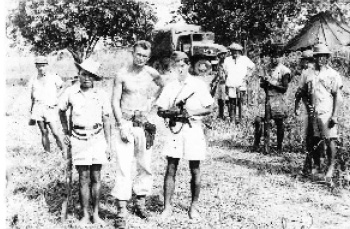
First Sergeant Elmer R. Young with members of Company D, 118th Regiment of the Philippine Guerrilla Force, Kabacan, Mindanao, during April of 1945. (First Sergeant Elmer R. Young Collection).
Philippines
US Forces would sail from the newly-built bases on Biak, Noemfoor, Hollandia, Ataipe, and Manus, for the Philippines. Their first target was to be the central Philippine Island of Leyte, followed by Luzon, various smaller islands, and Mindanao.
Mindanao, the southernmost island in the Philippine Archipelago, had an area of more than 36,000 square miles and was second in size to Luzon. Its irregular coastline and its number of bays afforded shelter at many places for a hostile fleet. Much of the beach line was flat and two large river valleys offered easy routes of advance into the interior of the island. The Zamboanga Peninsula jutting westward from the center of the island into the Sulu Sea was virtually indefensible and easily cut off at its narrow neck from the rest of Mindanao. Along the northeast coast was the Diuata Mountain range, a wild and largely unexplored interior. Transportation and communications on Mindanao were greatly inferior to those on Luzon. There were no railroads on the island and only two highways. The longest of these, Route # 1, followed a circuitous route from Digos on the east coast across the narrow waist of Mindanao to Cotabato then northward to the northeast tip of the island. Route # 3, named the Sayre Highway (in honor of the Philippine High Commissioner), extended southward through central Mindanao for a distance of about 100 miles, linking the northern and southern arms of Route # 1. The northern stretch of the road was well surfaced and usable in all weather, but the southern portion had a clay surface which suffered from the torrential rains. Additional means of transportation on Mindanao were provided by small vessels, which moved freely along the coast and up the island’s two large navigable rivers, the Agusan and Rio Grande. Between Mindanao and Luzon were the islands of the Visayas group, the most important of which were Cebu, Panay, Negros, Leyte, and Samar. most of these islands consisted of a central mountain area surrounded by coastal plains.
Lt. General Robert L. Eichelberger and his Eighth United States Army landed in the Zamboanga Peninsula, Mindanao Island on 10 March 1945 following the capture of Manila (3 March 1945, Luzon Island -ed). However, Japanese troops at Mindanao would fight a guerilla war in the mountains until the last days of the war. The main unit operating in the area was the 41st Infantry Division. Further operations in the southern Visayas were to be undertaken by units pertaining to the 40th Infantry Division (organic medical unit; 115th Medical Battalion) with the attached 503d Parachute RCT, and the Americal Division (organic medical unit; 121st Medical Battalion).
The 99th Evacuation Hospital, Semimobile was attached to the Eighth Army Area Command on 12 January 1945, and further attached to the 31st Infantry Division on 20 January. Staging was performed at Morotai Island, Netherlands East Indies for the Mindanao (V-5) Operation. During the preparation, instructions were given to carry in a 200-bed, combat loaded section and another bulk-loaded 200-bed section plus a thirty-day supply. A rear echelon consisting of 2 Officers and 21 EM was to be left behind with the 200-bed expansion unit and a lot of non essential supplies. Shipping space remained restricted, as part of the space had been allocated for storage of 7 loaded trucks and 10 amphibious trucks for easy transport of cargo and personnel on land or in water (dukws, 2 ½-ton, 6 x 6, amphibian truck –ed). The attached Quartermaster Laundry Platoon was loaded on the Liberty Ship.

Left: Dental work being carried out in the field.
Right: A battle casualty recovers on a ward of the 99th Evac Hosp.
(Both images from the collection of First Sergeant Elmer R. Young).
On 9 March 1945, US B-29 bombers began incendiary campaigns against Japanese cities. On 11 March, Eighth United States Army troops landed on Mindanao, Philippine Islands. On 1 April 1945, American forces landed on Okinawa. On 12 April 1945, President Franklin D. Roosevelt died, he was succeeded by President Harry S. Truman (-ed).
On 23 April 1945 – the 99th Evac forward echelon reached Parang, Mindanao, Philippine Islands. Officers and Enlisted personnel debarked from the LST at 2200 and the men on the Liberty Ship got off the boat as the trucks loaded with technical and fragile medical supplies were unloaded on the ground in torrential rain without proper care, causing breakage and damage.
On 24 April 1945 – 10 loaded dukws and all personnel (except the drivers), including the men of the 176th Quartermaster Laundry Platoon departed for Cotabato on borrowed transportation where they arrived at 1800 hours. The CO took the dukw party on to Manuangan enroute to Kabacan. The last truck finally came off the Liberty Ship the next day and the entire truck convoy now moved to Cotabato. Road conditions were not only bad, but LCM transportation was not available, so the truck convoy turned around and proceeded to Manuangan leaving part of the personnel at Cotabato. Because a bridge was out, the group had to halt one mile from the area. Limited ferry facilities compelled the group to bivouac at Ft. Pikit. Finally the trucks and personnel arrived at 1200 hours at Kabacan 27 April (without the 176th Quartermaster Laundry Platoon and its heavy equipment which got bogged down on the way). On 27 April 1945, the 99th Evacuation Hospital started functioning at 1500 opening to waiting patients with an initial capacity of 100 beds. This enabled the organization to provide medical service to the forward elements of the 24th and 31st Infantry Divisions. The personnel that could be spared at Ft. Pikit, proceeded to Kabacan on foot, a distance of 14 miles. Trucks were unloaded at Kabacan and dispatched to Manuangan to pick up the remaining personnel and equipment. Because of shortage of personnel, it was essential to have D Company, 118th Regiment, Philippine Guerrilla Force, assist in guarding the hospital site. As of 2400 hours, 160 beds were available and ready, and 41 patients were received. The hospital suffered no casualties from enemy action even though there were skirmishes nearby. One enemy soldier, hiding in a foxhole, was captured by one of the mess personnel within 25 yards of the Detachment’s mess as it was being established.
On 28 April 1945, the patient census reached 90. The remaining unit personnel only arrived at their destination on 29 April, and with help from native labor, the hospital installations were further established. Bed capacity was 200 and patient census 139.
On 30 April, Brigadier General Joseph C. Hutchinson (CG > 31st Infantry Division) visited the organization and conferred with Colonel Clifford G. Blitch (CO > 99th Evac Hosp –ed). Bed capacity was now 220 and patient census reached 176 as of 2400 hours.
Locations on Mindanao, Philippine Islands – 99th Evacuation Hospital
Kabacan 27 April 1945 > 16 May 1945
Maramag 16 May 1945 > 22 May 1945
Valencia 22 May 1945 > 23 July 1945
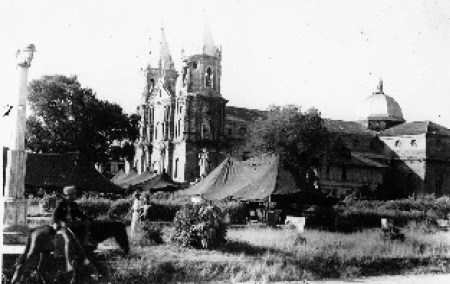
Ward tents of the 99th Evacuation Hospital in the plaza at Molo, Panay, Philippine Islands sometime between August and September 1945. (First Sergeant Elmer R. Young Collection).
The next day, 1 May 1945, Major General Franklin C. Sibert (CG > X Corps) visited the unit and made a brief inspection. Bed status was increased to 260, with a patient census of 220. On 2 May, 2 Officers and 9 EM of the 401st Medical Composite Unit were attached to the Hospital for rations only. Showers were finally operating. Bed status had meanwhile increased to 300, while patient census had reached 239. On 3 May, 3 Officers of the 90th Field Hospital bivouacking at Parang came to visit the unit and took some time to inspect the installations. Bed status remained at 300, with a patient census of 235. On 4 May, the attached 176th Quartermaster Laundry Platoon relieved from attachment was replaced by 30 native women who were contracted to do the unit’s laundry by hand. Bed capacity was now 300 and patient census 256. Work continued in the general hospital area; access roads were improved, trenches dug for drainage, and mail was received.
6 May 1945 – bed status reached was 380, with a patient census of 335. 7 May 1945, bed status was 444, and patient census 398. The hospital theater was completed the same day, however, much difficulty was experienced in the evacuation of patients (distance, bad roads, lack of transportation –ed).
By 8 May 1945 – bed capacity had reached 480. 10 Medical and 10 Surgical Technicians reported for TD from the 361st Station Hospital (Parang) to assist the 99th and plans were in operation to have the 90th Field Hospital set up 100 beds to relieve the unit as soon as possible. On 9 May, the 41st Quartermaster Laundry Platoon was attached to the organization. The 90th Field Hospital was in operation at 1900 hours and took over 49 patients. In the morning, 40 other patients were transferred to Parang to the 172d Station Hospital, and 11 went to the 30th Evacuation Hospital also established at Parang by LCM. As the 52d Field Hospital was in operation near Santa Cruz it relieved the 99th of many 24th Infantry Division casualties. The Commanding Officer conferred with Colonel McC. Downs, X Corps Surgeon, in the evening to review the medical tactical situation. As of 2400, the bed status was down to 540 and the patient census was 446.
10 May 1945 – usual hospital duties continued. Colonel Frank J. McGowan, MC (Surgical Consultant Eighth United States Army –ed) and Lieutenant Price (MC) and Lt. Colonel Sullivan (MC) from the Eighth United States Army Surgeon’s Office conferred with the CO and inspected the patients and the hospital. Evacuation had been speeded up by shuttling ambulances of the 411th Medical Collecting Company and the unit’s own 2 ½-ton trucks. The ration situation improved with meat and eggs now on the menu. Bed status was 540 and patients census 431.
11 May 1945 – the first death of the campaign was recorded; Pfc. Donald Jackson, E Company, 21st Infantry Regiment, 24th Infantry Division, died of wounds received in action. Usual hospital duties continued. Bed capacity was 540, patient census 430.
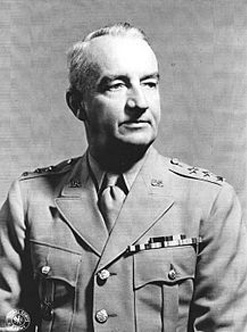
Portrait of Lieutenant General Robert L. Eichelberger (1886-1961), Commanding General, Eighth United States Army.
On 12 May 1945 – plans were tentatively made for a possible move. Bed status was still 540, with a patient census of 420. Informal inspections were held of the Detachment of Patients by Captain Frank L. Larsen, MAC, O-1542365. Usual hospital duties continued the following day with Sunday services being held for all religions. After meetings with X Corps Officers, a conference was held with the Chief of Sections and the senior NCOs and plans were discussed for a move to Maramag, Philippine Islands.
14 May 1945 – 200 beds and equipment were loaded onto the 2 ½-ton cargo trucks by 1700 hours. The remaining patients were to be evacuated as rapidly as possible, and whoever could not be transported would be transferred to the care of A Company, 263d Medical Clearing Company on their way.
15 May 1945 – a forward echelon consisting of 18 Officers and 111 EM departed at 0500. 16 Officers and 102 Enlisted Men remained. It arrived at Maramag at 0700 the following day after a tortuous trip over very poor roads. Some of the Officers were flown over in L-5B aircraft. The hospital was able to open on 16 May, but no patients were admitted. Formal inspections took place during the day.
17 May 1945 – the first 50 patients were admitted. Meanwhile the organization’s trucks returned to shuttle more of the hospital equipment forward. At the rear, as Officers could be released, they flew forward in L-5s. By 18 May, the forward echelon was well established on the Maramag Airstrip, which proved an excellent site.
20 May 1945 – the final convoy rear echelon arrived at 1745 at Maramag. Only 3 Officers and 35 EM now remained at Kabacan. A Company of the 263d Medical Clearing Company finally arrived and the remaining patients were transferred to them.
On 21 May 1945 – orders were received instructing the 99th Evac Hosp to move to Valencia, and the necessary preparations were made for another change of station.
22 May 1945 – the forward echelon moved out of Maramag at 1300 and reached Valencia at 1830 hours. Upon arrival the personnel proceeded immediately to set up, with patients being admitted at once. The site was again near an airstrip suitable for C-47 evacuation. Unit trucks once more left for the previous site to pick up the remainder of the rear echelon. The 20 Technicians on TD from the 361st Station Hospital were released 24 May and re-joined their unit. The 241st Quartermaster Laundry Platoon was re-assigned to the 531st Quartermaster Battalion as of 22 May; in fact it never did join the 99th. By 25 May, only the unit’s Supply Section and medical supplies remained in the rear. The maximum patient census never exceeded 250 since the unit’s setup at its new location. At Valencia the organization provided medical services to the 31st Infantry Division and forward elements of the 108th Regimental Combat Team of the 40th Infantry Division. The patients’ mess opened 25 May.
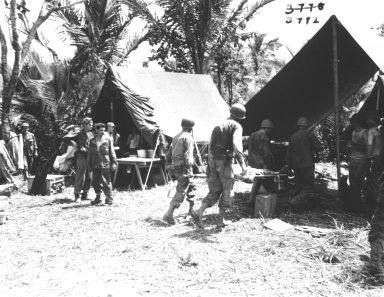
Picture illustrating the 12th Portable Surgical Hospital in Hollandia, Dutch New Guinea. These small units, with a 25-bed capacity, were initially developed to provide surgical care in jungle fighting. They were later often attached to TF to provide early frontline surgical care in amphibious operations.
On 26 May 1945, a convoy arrived from Kabacan and trucks returned for another load the same day. 1st Lieutenant Daniel G. Lipman, MC, O-533586, departed for the 24th Infantry Division near Davao for temporary duty.
27 May > 31 May 1945 – usual hospital duties continued. The first torrential rains fell in the afternoon of 27 May, luckily the area drained well. The same day the 411th Medical Collecting Company re-joined the organization. Bed capacity stood at 280 and patient census reached 230. By 28 May, the bed capacity was increased to 320, and the patient census reached 261. Impassible roads (due to heavy rains –ed) delayed arrival of the convoy from Kabacan. Some essential supplies and rations had to be flown in by C-47. Bed status was 320, and patient census 271. Showers were put in use on 30 May. Bed capacity was 360, patient census 296. On 31 May 1945, all personnel received their pay. Bed capacity still 360, patient census 300.
1 June 1945 – due to bad weather conditions the supply situation became critical, and the necessary medical supplies had to be ordered by radio for shipment by air! Beds 390, patients 392.
2 June > 9 June 1945 – usual hospital duties. Admissions greatly increased and expansion became imperative, however shortage of cots and ward equipment prevented this. More C-47s were requested to remove general and hospital cases that had been left behind as the prospects of opening the Sayre Highway were unfavorable. Bed status reached 420, with a patient load of 410. Some of the essential supplies arrived by air and one C-47 cargo plane became available for patient evacuation. Bed capacity was increased to 430, subsequently to 440, while patient census reached successively 363, 341, 371, 386, 406, 430… The 2 Officers who worked with the 99th on DS returned to their unit, the 162d Station Hospital. More essential supplies arrived by air on 5 June, but at this date the rear echelon was still at Kabacan. In order to hasten delivery of critical supplies, the Supply and Motor Pool Officers were detached by air to Parang to insure procurement. 1st Lieutenant Henry H. Thurston, MAC, O-1545264, arrived with some badly needed supplies in the morning of 6 June. One NCO; Staff Sergeant Kaiser and 2 Enlisted Men; Technician 5th Grade Krupowicz and Private First Class McGrath, received their orders to proceed to a Separation Point in the ZI for Discharge as all three were over 42 years of age. On 7 June, the organization received instructions to transfer the rear echelon to Parang for water shipment to Macajalar Bay, Northern Mindanao, then to Valencia by road. 1st Lieutenant Henry H. Thurston, MAC, O-1545264, departed by L-5 to Kabacan to supervise the movement, which was supposed to take two to three weeks time. Captain Larsandrew Dolan, MC, O-1841851, was relieved from his temporary assignment to the 395th Medical Collecting Company and assigned to the 99th Evac. Although already assigned 4 June, he only arrived much later. Conferences took place between the 99th Evacuation Hospital staff and the Eighth United States Army Surgeon’s Office.
10 June 1945 – Sunday was observed. As of 5 June the 99th was officially attached to the 31st Infantry Division for operational control. Fourteen EM were assigned to the organization from Headquarters, 4th Replacement Depot, APO 703 – 1 F/Sgt, 1 Mess Sgt, 3 Lab Technicians, 4 X-Ray Technicians, 1 Optician, 1 Dental Lab Technician, 1 Surgical Technician, 2 Medical Noncommissioned Officers. Brigadier General Joseph C. Hutchinson, visited the Hospital. Bed capacity was 440, patient census 364.
11 June 1945 – usual hospital duties continued. The PX supplies arrived by C-47, and the Post Exchange was subsequently opened to patients and personnel, a boost to general morale. A ward fly was erected in the movie area as a protection against the rains. Captain Ernest Freshman, MC, O-496033, I & E Officer, started broadcasting the daily news. Bed status 440, patient census 354. Usual hospital duties carried on, bed capacity remained at 440, and patient census reached 381. Technical Sergeant Willard F. Kuebler was appointed Warrant Officer, Junior Grade, USA, W-2135028, effective 3 June 1945. On 13 June, supplies finally arrived for expansion of the organization to 600 beds. The 411th Medical Collecting Company set up 8 complete wards to accept minor cases from the Receiving Section and some convalescent patients from the own wards, with 411th Med Coll Co doctors performing medical service. The administration was done by the 99th. Bed capacity now reached 540, with a patient census of 393.

Troops of the 118th Regiment, Philippine Guerrilla Force, with an unidentified member of the 99th at Kabacan, Minda. (Elmer R. Young collection)
14 June 1945 – usual hospital duties. The PCAU (Philippine Civil Affairs Unit –ed) civilian Dispensary and Hospital opened at Valencia for seriously ill or injured civilians. Bed capacity, 540, patient census 390. Captain Schneider, Catholic Chaplain, joined the organization on TD from X Corps. Some of the missing supplies came in by C-47, the rest was still waiting at Parang for transportation by water to Bugo; the unit’s 4 2 ½-ton trucks, 1 ¾-ton weapon carrier, and 1 ¼-ton truck were on the Malabang-Cagayan highway enroute to the hospital. Bed status 540, patient census 395. On 16 June, work started on a Chapel. All but 2 of the newly-assigned Enlisted Men finally reported. Bed status, still 540, patient census 394. Sunday was observed on 17 June with both Protestant and Catholic services held in the tent-chapel. Major James G. Dees, MC, O-323884, joined the organization 17 June after having been relieved from assignment to the 17th Portable Surgical Hospital, APO 718. Bed status 540, patient census 441. The personnel mail situation became critical; the last mail was received 10 days ago and the tactical situation precluded normal delivery. The newly assigned EM who already came in, were assigned to position vacancies regardless of their specialized training. Bed status 540, patient status 430. On 20 June, bed capacity reached 560, with patient census 458. On 21 June, bed capacity was already 580, with a patient census of 433. Mail finally arrived on 22 June, together with the news that the bulk-load had reached Bugo and that it was to remain with the Medical Supply Section until the unit could come and collect it. Trucks were still on their way overland from Parang, progressing slowly. Bed status 580, patient census 382. There was another inspection by the CG X Corps and Staff, and everybody seemed favorably impressed. Drainage ditches were constructed in the area with help of a borrowed Engineer grader. Bed status 580, patient census 353. One of the organization’s cooks, Private First Class Leonard Lentz departed for the US on 23 June, to be discharged under the “40-year old” plan.

Illustration showing partial set up of the 99th Evac Hosp somewhere in the Philippines, 1945. (Elmer R. Young collection)
On 24 June 1945 – orders were received from Headquarters, 4th Replacement Depot, USAFWESPAC, APO 703, assigning an additional number of EM to the unit, effective 25 June. In total 4 Medical Technicians, 2 Surgical Technicians, and 1 Meat & Dairy Inspector were assigned. Admissions were now more of the general medical and simple surgical natures; serious casualties were greatly reduced. Bed capacity 580, patient census 321. No changes in bed status; patients census respectively reached 309, 299, and 294.
27 June 1945 – orders were received relieving Chaplain Schneider of his DS with the 99th Evac and assigning him to the 155th Infantry Regiment, 31st Infantry Division, APO 31. Captain Keith MacMilan, MC, O-419155, was relieved from assignment to the 656th Medical Clearing Company, APO 159, and effectively assigned to the 99th Evac. Secret orders were received informing the CO of the possibility of re-assignment to the Sixth United States Army in the future. On 28 June, some of the newly assigned Enlisted personnel reported for duty. Part of the long expected supplies shipped from Parang by water finally arrived. Bed capacity was 580, patient census 282. Eight new radios, requisitioned from Special Service, were installed for patient entertainment. Another EM, Technician 5th Grade Frank Coughlin departed for the ZI to be discharged (he was over 42 years old). Three Officers were evacuated off the island for hospitalization. Bed capacity remained at 580, while patient status reached 282, 289, and 307.
30 June 1945 – usual hospital duties and activities continued. All personnel were duly paid. Seventy-five percent of the cases admitted were battle casualties ranging from minor wounds to serious, complicated ones. As the campaign progressed, the fighting became lighter and more medical cases began coming in.
The Luzon Campaign was concluded successfully (official duration 15 December 1944 > 4 July 1945 –ed).
The 99th Evacuation Hospital, Semimobile, was assigned to the Eighth United States Army and attached to X Corps for the Mindanao Campaign. Up to the beginning of the third quarter 1945, the unit was located at Valencia, Mindanao, P.I. The organization ceased functioning on 23 July 1945 with all remaining patients being transferred to the 90th Field Hospital located nearby, evacuated by air to a General Hospital, or returned to duty. The hospital then shuttled to Bugo.
At 1645 hours, 27 July 1945, the Meritorious Service Unit Plaque was awarded to the 99th Evacuation Hospital by Lt. Colonel Hall, Surgeon, X Corps, on behalf of the Commanding General; while Colonel Clifford G. Blitch, MC, O-19302, was presented the Bronze Star Medal. These first awards were received for the outstanding efforts made by the organization during the Mindanao Operation.
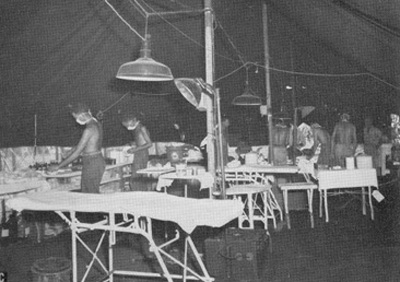
Mosquitoproof operating room of the 99th Evacuation Hospital.
1 July 1945 – Sunday was observed. Major Daniel Snydacker, MC, O-481868, Chief of EENT Section, flew to Del Monte to investigate the delay in delivery of glasses ordered three weeks earlier. Patient status was 314 (70 of which were members of the Philippine Army or Filipino civilians). On 2 July, all personnel saw the Readjustment & Redeployment Movie “Two Down and One To Go” (on which was based WD Pamphlet No. 21-31 describing that now that Italy and Germany had been licked, it was time to crush Japan –ed). Patient status 310. On 3 July some of the organization’s trucks were detailed to the 31st Infantry Division for convoy work. Captain Frank L. Larsen, MAC, O-1542365, gave a course on M-1 Carbine familiarization to the newly assigned EM. One Officer was evacuated off Mindanao for hospitalization. Patient census 235. On 4 July patient status was 229; and on 5 July it was reduced to 226. On 6 July an important meeting was held with the CO and all Officers to discuss R-R policy as it affected Officers. Some Officers were evacuated off the island for hospitalization. Patient census was 201. It remained unchanged on 7 July; and reached 300 the following day. Inspections took place with conferences on neuro-psychiatry.
On 9 July 1945 – usual hospital activities carried on. “Ward 411” was closed and taken down; own wards were gradually taken down as well, decreasing bed status to 280. Patient census reached 188. The 90th Field Hospital now at Kabowie moved to a location about one mile north of the 99th Evac on the Sayre Highway, and that was the place where the unit’s remaining patients would be taken to. Another Medical officer returned from DS at the 52d Field Hospital. Patient census 189.
11 July 1945 – secret orders were received from Eighth US Army Headquarters, notifying the organization that the next location was to be Panay, P. I. The following T/O & E 8-581 Change dated 25 March 1944, was also received by Letter, Headquarters, Sixth United States army, APO 442, Adjutant General 400-N, Subject: Sixth US Army Special Changes to T/O & E 8-581, dated 25 June 1945, providing for newer equipment more suitable for operation in a temperate zone. Patient census was 194. The next two days patient status only reached 164.
13 July 1945 – the unit’s CO conferred with the Chiefs of Sections how to load and shuttle the equipment and supplies to Bugo for further movement by water expected around end of July. The first shuttle was to leave the next day, roads permitting, for the dump established at the 74th Medical Supply Depot; the 5 trucks still enroute to Valencia from Malabang would be unloaded there also. A first beer issue of one case per man was received, a real treat! On 14 July Colonel Wright, US Public Health Service; Dr. Faust, Professor of Tropical Medicine at Tulane University; and Dr. MacMullen, Professor of Tropical Medicine and Parasitology at the University of Oklahoma arrived for field studies. They were to study tropical diseases, with schistosomiasis being their chief concern. Patient census was 180.
15 July 1945 – the hospital was attached to the 31st Infantry Division as per Letter, Headquarters 31st Infantry Division, Office of Division Surgeon, Subject: Extracts from Annex No. 4 to Administrative Orders No. 4, Medical Plan, Headquarters X Corps, APO 310, 9 July 1945, dated 13 July 1945. Patient status was 187. Second Lieutenant Johnie R. Trim, MAC, O-1690733, was promoted to 1st Lieutenant effective 3 July 1945. The organization’s trucks still en route from Malabang finally reached Del Monte and unloaded their equipment. They would later proceed with the convoy to Valencia. Patient status reached 173. On 17 July patient census was 166; on 18 July it reached 161. The same day, Captain Theodore C. Gerwig, Jr., MC, O-564721, was placed on TD with the Eighth United States Army Processing Team, APO 310. Captain Walter M. Block, MC, O-521006, and Technician 5th Grade Burdette MacNaughton departed for the US on TD. A new “Station List No. 9” was received from Headquarters, X Corps, dated 16 July 1945, stating that the 99th was attached to the 31st Infantry Division for operational purposes only. Part of the convoy from Bugo arrived at the hospital area the afternoon; the rest was expected in the evening. Usual hospital duties continued the following day. Some members of the Tropical Medicine Research Commission departed for Leyte by air. Patient status reached 145.
20 July 1945 – the CO conferred with his Staff regarding the next move to the Port at Bugo to embark. Pursuant to the authority contained in General Orders No. 133, Headquarters, Sixth United States Army, APO 442, dated 30 June 1945 (Page 29), the 99th Evacuation Hospital was relieved of its assignment to the Eighth US Army and re-assigned to the Sixth United States Army upon arrival at the new site at Panay. The unit would then be attached to I Corps. Special Orders No. 104, Headquarters, 99th Evacuation Hospital, dated 20 July 1945, relieved Captain Ernest Freshman, MC, O-496033, from the Operating Section and assigned him to the Ward Section, and relieved Major Claude C. Curtis, MC, O-381361, as Chief of Medical Service and assigned him to the Operating Section; Major Donald P. Morris, MC, O-1685266, was appointed Chief of Medical Service replacing the former Officer. Memorandum No. 45, Headquarters, X Corps, dated 17 July 1945, informed the organization that the “V-5 Operation” (Mindanao campaign –ed) was terminated 30 June 1945. Patient census reached that day was 147. The first 4 EM eligible for discharge left for the Zone of Interior. The other scientists studying Tropical Medicine in the area departed for Davao, where they were to continue their research. The hospital started its close down. No more patients were accepted as from 22 July. Two Officers left for Bugo in order to establish a bivouac. They were accompanied by 5 trucks loaded with equipment. The personnel continued to close down the installation and consolidate. On 23 July, all patients were evacuated to the 90th Field Hospital; the area was cleared except for personnel tentage and the necessary trucks loaded. All Medical Corps Officers went forward by C-47 aircraft to Del Monte and then to Bugo by truck. Loading continued the next day, with more personnel sent out by air. Colonel Clifford G. Blitch (CO > 99th Evac Hosp) and 1st Lieutenant Johnie R. Trim (Adjutant > 99th Evac Hosp) left by plane on 25 July. Enemy organized resistance ended on Mindanao.
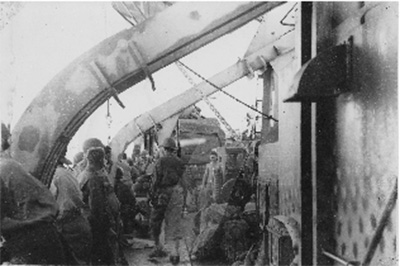
Members of the 99th Evacuation Hospital at sea, possibly in transit to Morotai Island from Hollandia on 14 September 1944. (Elmer R. Young collection)
26 July 1945 – the main convoy left Valencia at 0730 for Bugo where they arrived at 0400 hours the following day. On 27 July, the 291st Ordnance Inspection Team inspected all vehicles and guns for combat serviceability (except for sight, all guns were in excellent condition – vehicles were found to be only fair and much work needed to be done to remedy the situation –ed).
On 29 July, the entire unit was ready to load. The 99th Evac departed on 3 LCMs for Panay at 0300 hours, 30 July, arriving at destination 31 July 1945. Upon arrival the hospital was relieved of its Eight US Army assignment, and re-assigned to Sixth United States Army, and attached to the 40th Infantry Division. It was set up in the town plaza of Molo, Panay, Philippine Islands to stage for the next operation. During this month of staging, rest and recuperation were important, with rechecking of supplies and unit equipment and submission of requisitions. I & E Training with Japan now being the main subject was conducted. Officers attended courses dealing with “Military Government”.
31 July 1945 – the hospital arrived at Iloilo, Panay, Philippine Islands, at 1000 and debarked. Personnel and vehicles proceeded to set up in Molo (one mile from Iloilo –ed) in the central park in front of a large Cathedral and Convent. The area was rather small but suited basic requirements. The new APO became 715. The CO held a general call at 1900 hours for orientation purposes. Work in the area continued the following days. There was a permanent guard detail, as there were many civilians in the area. Showers were constructed and the major Sections and CP were established on the park sidewalks. Power supply came from the city power house; Officers occupied a house adjoining the area; and another building was taken over for tent storage. The first passes were issued to the Enlisted personnel on 2 August. On 4 August 1945, Captain Frank L. Larsen, MAC, O-1542365, left for Manila by air to procure a new movie projector. Internal inspections took place the following days. Recreation was taken care of, consisting of concerts, USO shows, movies, basketball, swimming, 2 beach clubs, and passes to Iloilo until 2400 hours. Sunday services were observed on 5 August.
6 August 1945 – an EM clothing and equipment showdown and a Ward Section inspection were held; requisitions for all T/E shortages were prepared for submission to the 40th Infantry Division and Sixth US Army Headquarters the following day.
Important news was confirmed: a first Atomic bomb was dropped on Hiroshima, Japan.
On 7 August, Captain Gordon M. Jensen, MC, O-1785304, reported to the 37th Field Hospital to render temporary assistance; 5 Medical and 5 Surgical Technicians were to report there as well the next day. Lt. Colonel Willam E. Looby, MC, O-384523, Major Claude C. Curtis, MC, O-381361, Major Donald P. Morris, MC, O-1685266, Captain Eben Alexander Jr., MC, O-441309, and Captain Raymond C. Waisman, MC, O-496170 departed for Leyte to check cases they had evacuated to General Hospitals there and to investigate recent surgical and medical findings. Two Laboratory Technicians were loaned to the 115th Medical Battalion (40th Infantry Division –ed). On 9 August, a staff conference was held including all personnel during which the CO emphasized the need for perfection in housekeeping, personal appearance, uniform regulations, motor maintenance, mess maintenance, and future training. A permanent malaria detail consisting of Staff Sergeant Lucal, Corporal Green, and Private First Class Wylie attended the first of a two-day course in malaria control given by the 40th Inf Div Surgeon.

Monsoon conditions at the 99th Evacuation Hospital. (Elmer R. Young collection)
A second A-bomb was dropped on Nagasaki, Japan the same day.
All Enlisted personnel were paid on 10 August and underwent a physical inspection. All housekeeping and motor pool details were ironed out. On 11 August, an inspection was held of the Detachment of Patients, Officers were paid, and the first mail-call was held in the afternoon. Now that the principal housekeeping tasks were under control, the unit was settling down to a kind of garrison existence. Morale was high because of improved living conditions and a certain return to ‘civilization’, and because of the amazing progress of the war in this Theater of Operations! As usual Sunday was observed with religious service on 12 August. The new movie projector arrived from Manila and it was used for the first time with excellent results.
13 August 1945 – Information and Education courses started. Quite many cases of hepatitis infections, with jaundice, were received and hospitalized. On 14 August, Technician 5th Grade Peacock departed for the ZI on TD. Page 1, General Orders No. 91, Headquarters, United States Army Forces in the Pacific (USAFPAC), dated 4 August 1945, authorized full battle honors for the 99th Evac for its participation in the Southern Philippines Campaign (official duration 27 Feb 45 > 4 Jul 45 –ed). Captain Curtis C. Hambo, MC, O-295720, gave a lecture on VD to all personnel at 0800. The CO and the Administrative Chiefs of Sections inspected a ‘model unit’ and made preparations to complete one of their own (no bamboo was furnished as yet). Corporal Nail was transferred to the Eighth US Army. Civilian laborers arrived and started working in the area; bamboo was soon received and a regular production of bed racks and wash stands was started. Lieutenant General Robert L. Eichelberger (CG > Eighth US Army) sent a Commendation to the 99th Evacuation Hospital for its outstanding service during the Mindanao Campaign. Confirmation was received that Captain Curtis C. Hambo, MC, O-295720 and Captain Robert E. Sager, MC, O-1690436, were promoted to the temporary rank of Major, effective 23 July 1945.
Some Medical Statistics
About 75% of all cases admitted in the Medical Service were battle casualties
57% of the wounds received by the Surgical Service were of extremities
About 50% of diseases encountered were found to be related to malaria
20% of all disease cases had dermatitis
Filipino civilians and guerrillas mostly suffered from malnutrition, avitaminosis, and malaria
In the meantime, President Harry S. Truman received Japanese acceptance of the unconditional surrender ultimatum on 14 August 1945.
Work continued in the area and on equipment the next days.
On 18 August, Technician 5th Grade Galley reported for duty as the Chaplain’s new assistant. Special Troops Inspectors of the 40th Infantry Division came to the unit; preparation of the area for the General’s Inspection on 19 August continued. However, due to inclement weather and other important matters Major General Donald J. Myer’s (CG > 40th Infantry Division) visit did not take place. The hospital was relieved from attachment to I Corps but attached to the 40th Infantry Division, effective 15 August 1945, as per Point 276, General Orders No. 165, Headquarters, Sixth United States Army, APO 442, dated 11 August 1945. Major Robert V. Sager, MC, O-169036 was hospitalized with jaundice on 16 August; and Captain Irving, S. Schwimmer, DC, O-448027,returned to duty from the hospital.
20 August 1945 – efficiencies noted during Saturday’s inspection were corrected and more bamboo became available. Warrant Officer, Junior Grade Willard F. Kuebler, W-2135028, was appointed Assistant Adjutant of the organization. Two representatives of IX Corps Surgeon’s Office, Eighth United States Army arrived to confer with the Commanding Officer. Subjects treated concerned transfer of the 99th to their command, the forthcoming operation in Northern Honshu in autumn, and preparations for the next task – the Occupation of Japan. The meeting continued the next day. Meanwhile construction of bamboo racks and wash stands continued with Filipino civilian assistance. At 1615, 21 August 1945 – Colonel C. G. Blitch held a general assembly to inform the EM of future plans and to present Good Conduct Ribbons and Driver’s Medals to a number of men. By 22 August all tents received bamboo racks and a wash stand of uniform design, and the civilian labor was discharged.
On 23 August 1945, 1st Lieutenant Daniel G. Lipman, MC, O-533586 departed for the 41st Infantry Division, APO 41, his new assignment. On 25 August, Captain Frank L. Larsen held a formal inspection of Enlisted personnel and M-1 Carbines at 0900 hours. The CO, assisted by the XO, made tent and section inspections at 0945. All personnel took the first in a series of anti-plague shots. Cholera activator shots were given on 26 August. On 27 August, all Officers attended compulsory lectures on ‘Military Government’ (in view of occupation duties in Japan –ed). A Typhus activator shot was given to all personnel the same day.
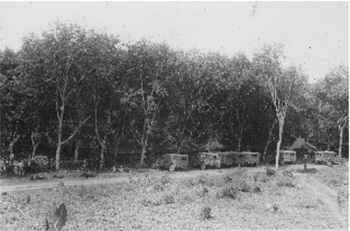
Illustration showing WC-54 Ambulances of the 99th Evacuation Hospital at the unit’s facility on Mindanao Island, 1945. (Elmer R. Young collection)
On 28 August 1945 the 99th Evacuation Hospital received a personal Commendation from Major General Franklin C. Sibert (CG > X Corps) for its excellent service in the Mindanao Campaign.
More new individual equipment and cold weather clothing was issued.
On 29 August 1945 a message was received from XI Corps at 1900 hours (via Headquarters, 40th Infantry Division –ed) instructing the organization to load on LSTs with Companies A and B, 745th Tank Battalion for an unknown destination. Preliminary instructions for the move were issued by the CO to all Officers. Mobile loading was accomplished on 30 August and preparations made for bulk loading the LSTs. All Officers and EM loaned to other medical units returned including the hospitalized EM. All men 37 years of age and over and many with 85 points (ASR score –ed) or more were transferred temporarily to the 37th Field Hospital at Iloilo to await transportation to a Separation Center in the United States.
1 September 1945 – all personnel were paid. Major Herman L. Taft, MC, O-487681, returned to the unit from the hospital. The 2 LSTs came in late, but as one was unserviceable (LST 133) and loading was consequently delayed pending decision as to its use. Partial loading of LST 745 was accomplished. A theft of wool blankets was detected the night before and the offender apprehended.
On 2 September 1945, the Japanese delegation signed the official Instrument of Surrender on board the USS Missouri anchored in Tokyo Bay.
Captain Eben Alexander, Jr., MC, O-441309 returned to the 99th from the hospital.
By 3 September, half of the unit’s vehicles and half of the Officers were loaded on LST 745. The unit was meanwhile re-assigned to the Eighth United States Army, effective 15 August 1945, and placed under jurisdiction of XI Corps. On 5 September, half of the EM were also loaded on LST 745 which had pulled out into the stream. The delay was also caused by the late arrival of many requisitioned supplies required to function as a 400-bed medical unit for two to three weeks. Blackout restrictions were lifted on 8 September, making overall living conditions much better.

July 1945, Mindanao, Philippine Islands. Civilian Filipino laundry girls in action. In order to alleviate the lack of proper attached Quartermaster Laundry Platoons, contracts were signed with local authorities, schools, orphanages, convents, and churches, to provide extra services to US Forces stationed in liberated areas of the Philippines.
On 9 September 1945, the convoy finally departed Iloilo Harbor, Panay, Philippine Islands, at 1130. A sick man had to be evacuated from the ship to the hospital before departure. The last anti-plague shot was given on board prior to the vessel’s arrival at Batangas Bay, Luzon, Philippine Islands at 1630, 10 September 1945. Ship duties were carried out during 11 and 12 September. This day, both LSTs (LST 745 + LST 133 –ed) beached to discharge another unit which had also made the trip with the 99th Evac. New units came aboard on 13 September. On 14 September LST 133 took aboard 900 sailors and departed for Manila at 1800; LST 745 remained in the Bay. LST 133 reached Manila Harbor, Luzon, P.I., at 0800 hours, 15 September. Another sick EM was evacuated to an inland hospital. On 16 September 1945, LST 133 docked at Cavite Naval Base and discharged the 900 sailors then proceeded to the water ship and reloaded. A few Officers managed to get ashore and visit Manila. LST 133 then moved to the mouth of Manila Bay to depart as soon as the weather permitted. The LST departed Manila Bay the next day, and sailed for Batangas Bay to rejoin the convoy and LST 745. A sick man was hospitalized from the ship. Colonel Clifford G. Blitch commanded all troops on LST 745, while Major Joseph E. Barnes, commanded all personnel traveling aboard LST 133.
The completed convoy departed Batangas Bay at 0600, 20 September, passing Corregidor Island at 1800, and Subic Bay at 2400 hours. The sea was rough. The convoy sailed past Lingayen Gulf at 0800, 21 September 1945.
Recommendations and Findings
Tentage used under tropical conditions was inadequate and approximately 50% needed to be replaced before going on another operation
Generators and electrical equipment suffered a lot
Some medical items were difficult to procure
The supply situation suffered because of long supply lines, bad roads, and frequent moves, and often had to take place by air
The necessity for mobility, versatility, and adaptability of both individual and unit, were the most significant lessons to learn on this operation
Japan
29 September 1945 – the convoy arrived in the Yokohama dock area at 1000. At 1300 hours, LST 133 was beached at the Kawasaki LST slots and Major Joseph E. Barnes, MAC, O-1541100 (XO > 99thEvacuation Hospital –ed) reported to the Eighth US Army and XI Corps authorities for instructions. LST 745 beached at 1800 and both ships started unloading. The bulk was stockpiled on shore and the vehicles formed in convoy. Personnel remained on board as no area had yet been designated. On 30 September, Colonel C. G. Blitch reported to the Surgeon, XI Corps, in Tokyo. The motor convoy then proceeded to Hara-Machida (northwest of Yokohama) at 1000 with the personnel following at 1300 hours. All personnel then settled in former Japanese garrison barracks around 1500 the same day. All personnel were adequately housed together with Mess, Headquarters and part of the unit’s supplies. Electric power was available. Japanese latrines had been sprayed with DDT and closed, and deep pit latrines and boxes were now in use. Running water was available for washing, with drinking water coming from an Engineer water point (distributed in Lyster bags and water trailers –ed). Supplies were all grouped under cover. A large room was made available for movies and church services and Enlisted personnel had a dayroom. Laundry remained an individual problem, 220 cu ft mobile refrigerators were used for perishables and biologicals. One shower unit was installed and provided heated showers.
The 99th was able to function as a 400-bed installation although lacking some technical equipment (already 3 years old –ed), such as the X-Ray Section. Under the current Discharge Program, personnel were rapidly being depleted, but at the present time there was adequate strength for operation.

Top: Illustration of LST 133, one of the vessels that sailed together with LST 745, part of a large convoy that left Manila, Philippine Islands, on 17 September 1945, with destination Yokohama, Japan.
Bottom: Illustration of LST 745, which carried part of the 99th Evacuation Hospital personnel and equipment to Japan.
Note: The opening of the year 1946 found the 99th Evacuation Hospital, Semimobile, assigned to the Eighth United States Army and attached to XI Corps. The organization was located near Utsunomiya, Honshu, in barracks formerly occupied by Japanese Signal Corps troops of the 43d Japanese Infantry Regiment. Unit strength was 17 Officers and 155 Enlisted Men. Rapid depletion in command strength was experienced through losses under the current Readjustment process. Officers and Enlisted Men were regularly transferred on TD to other units for a few days; others moved to the 4th Replacement Depot for shipment to the Zone of Interior. Patient census was never high, remaining under 20 for the current period. A few Officers joined the organization to compensate for the recent losses. Major Robert H. Simpson, MC, O-1699875, formerly Chief of Surgical Service, served as Hospital Commander initially. He was succeeded by Captain Raymond C. Waisman, MC, O-496170, on 4 February 1946. Finally, it was Captain Henry E. Steadman, MC, O-477159, who assumed further command on 10 February until the organization’s final inactivation 28 February 1946.
As the hospital moved into the final phase of its activity, professional services were reduced in scope, luckily there were few patients to treat, the average bed status being 12. A total of 20 patients were evacuated to the 42d General Hospital in Tokyo (distance 70 miles –ed). Medical support in this period was mainly rendered to the 3d Battalion, 387th Infantry Regiment, 97th Infantry Division. On 18 February 1946, the hospital stopped receiving patients and preparations were made to re-assign all non-eligibles to other organizations. Unit strength was reduced to 8 Officers and 69 Enlisted Men. Most transfers went to either the 96th Medical Battalion or the 4th Replacement Depot. The rear echelon that closed the hospital after deactivation consisted of 1 Officer and 12 EM – the date was 28 February 1946, the location, Utsunomiya, Honshu, Japan.
Statistics – 99th Evacuation Hospital (1 January 1946 > 28 February 1946)
Admissions – 77 (disease) 13 (non-battle injury) 0 (battle casualty)
Dispositions – 16 (disease) 4 (non-battle injury) 0 (battle casualty)
Return To Duty – 85 (disease) 15 (non-battle injury) 0 (battle casualty)
Communicable Disease – 29 cases
Operations – 21 performed
Personnel Roster
Officers (30 September 1944 – 28 February 1946):
ALBRIGHT, Richard L., O-1997249, 2d Lieutenant, MAC
ALEXANDER, Eben, Jr., O-441309, Captain, MC
ARRANAGA, Salvador, O-2047227, 1st Lieutenant, MAC
BARNES, Joseph E., O-1541100, Captain, MAC (Executive Officer, 99th Evac Hosp) (promoted to Major)
BAYLES, Weston L., O-2051041, 1st Lieutenant, MAC
BERNARD, Cohn H., O-1693230, Major, MC
BLITCH, Clifford, G., O-19302, Colonel, MC (Commanding Officer, 99th Evac Hosp)
BLOCK, Walter M., O-521006, Captain, MC
CHIOTA, Joseph A., O-496253, Captain, MC
CONTENTO, Salvatore J., O-1689971, Captain, MC
CRAIG, Louis A., Jr., O-435170, Captain, MC
CURTIS, Claude C., O-381361, Major, MC
DEES, James G., O-323884, Major, MC
DOLAN, Larsandrew, O-1841851, Captain, MC
DONALDSON, Joy K., O-281814, Major, MC
EPSTEIN, Alexander, O-1715344, Captain, DC
FRESHMAN, Ernest, O-496033, Captain, MC
GERWIG, Theodore C., Jr., O-564721, Captain, MC
GOODYEAR, Emil S., O-496416, Major, MC
GRIFFIN, John E., O-1701518, 1st Lieutenant, MAC
GRUENEBAUM, Julius L., O-1541153, 1st Lieutenant, MAC (promoted to Captain)
HALL, Emory H., O-1684853, Captain, MC (promoted to Major)
HAMBO, Curtis C., O-295720, Captain, MC
HARDIN, Jimmie W., O-932576, 1st Lieutenant, ChC
HARTUNG, Frank H., O-1702483, Major, MC
HOFFMAN, Abraham C., O-926745, Captain, MC
HURLEY, James W., O-420255, Captain, MC
JENSEN, Gordon M., O-1785304, Captain, MC
KORKOSZ, August B., O-319909, Captain, MC
KUEBLER, Willard F., O-2135028, Warrant Officer Junior Grade, USA
LARSEN, Frank L., O-1542365, Captain, MAC
LIPMAN, Daniel G., O-533586, 1st Lieutenant, MC
LOOBY, William E., O-384523, Major, MC (promoted to Lt. Colonel)
MACMILAN, Keith D., O-419155, Captain, MC
MACRAE, Colin, O-489774, Captain, MC
MAHON, Thomas A., O-1701574, 1st Lieutenant, MAC
MARQUER, Victor B., O-399467, Major, DC
MAYER, Robert C., O-463463, Captain, MC
MILLER, David, O-300696, Captain, MC
MILLER, Samuel, O-1660014, Captain, MC
MORRIS, Donald P., O-1685266, Major, MC
NESBITT, Isaac F., O-1734779, 1st Lieutenant, MC
O’NEILL, Gerald D., O-485499, Captain, DC
PEBWORTH, James T., O-244201, Major, MC
PYBAS, Garth L., O-505828, Captain, ChC
READ, Charles T., O-350174, Captain, MC
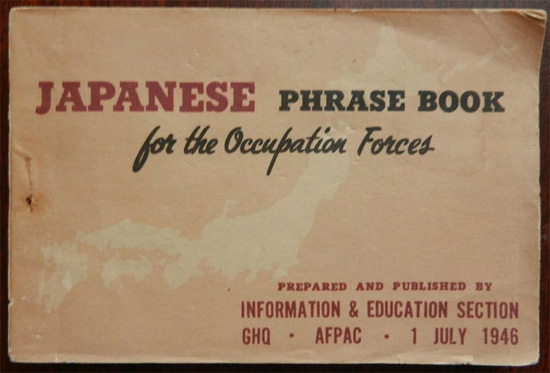
Japanese Phrase Book prepared and published by the I & E Sections, General Headquarters, American Forces in the Pacific, dated 1 July 1946, and distributed for use by the American Occupation Forces in Japan.
SAGER, Robert V., O-1690436, Captain, MC
SASSAMAN, Paul F., O-1547773, 2d Lieutenant, MAC (promoted to 1st Lieutenant)
SCHLOSBERG, Charles, O-496276, Captain, MC
SCHWARZ, Leonard, O-422716, Captain, MC
SCHWIMMER, Irving S., O-448027, Captain, DC
SIMPSON, Robert H., O-1699875, Major, MC
SMULLEN, Willard C., O-461536, Major, MC
SNYDACKER, Daniel, O-481868, Major, MC
STEADMAN, Henry E., O-477159, Captain, MC
TAFT, Herman L., O-487681, Major, MC
THURSTON, Henry H., O-1545264, 1st Lieutenant, MAC
TRIM, Johnie R., W-2105466, Chief Warrant Officer, USA (promoted to 2d Lieutenant, MAC, O-1690733)
WAISMAN, Raymond C., 0-496170, Captain, MC
WARREN, Jacob P., O-354144, Major, MC
ZISKIND, Morton M., O-473196, Captain, MC

Parade of 99th Evacuation Hospital staff taken in 1945. (Elmer R. Young collection)
Enlisted Men:
| Adamez, Nicolas S. | Gugliaro, Lawrence | Poole, Dennis C. |
| Allen, William R. | Guidry, Danis | Posada, Martin H. |
| Allison, Otis G. | Hall, Calvin L. | Powanda, John |
| Ames, Vern C. | Hall, Rodney D. | Purdy, Edward H. |
| Apple, George L. | Hansmann, Monroe W. | Raggi, John J. |
| Babar, Marvin C. | Henderson, Marion E. | Rallis, Allen F. |
| Babel, Cecil D. | Hendrickson, Roy E. | Rathbon, Jay, F. |
| Bajula, Paul D. | Hilliker, Harvey B. | Reeves, James E. |
| Bartee, Lloyd | Hoffman, William R. | Regnter, Edward J. |
| Baty, William | Homa, Ervin H. | Reicrenthal, Sidney |
| Baumann, John H. | Hope, Norwood W. | Rhode, George C. |
| Baylor, Chester W. | Hornbeak, Max W. | Rivkin, Hyman J. |
| Bell, Harols W. | Houser, William J. | Robert, Ovila P. |
| Bergeron, Sidney A. | Houtz, Donner E. | Rock, Fred G. |
| Bernad, Gudalupe R. | Huerta, Rudolph | Rodriguez, John A. |
| Bernath, Michael S. | Hurst, William R. | Rohmer, Carl |
| Berneburg, Fred W., Jr. | Indrelle, Hans | Romano, Frank A. |
| Bina, Bernard | Jones, Joseph O. | Rondinelli, Mario S. |
| Boynton, Robert W. | Jones, Oscar H. | Roten, J. D. |
| Bratton, Tullie J. | Jones, Ronald L. | Rountree, Arville W. |
| Brown, Roy L. | Joseph, Paul C. | Salazar, Joe |
| Bruso, Georhe J. | Kalamen, Martin | Sandoval, Reuben |
| Bueml, Anthony R. | Kandler, Russell F. | Sanford, Paul lR. |
| Cantrell, Alton L. | Kavalaukas, John | Satterfield, William M., Jr. |
| Catha, Advil | Kidd, Charles | Scaldini, Louis O. |
| Cavazos, Manuel C. | Kinney, Paul P. | Scanlon, John F. |
| Chapparo, George M. | Kirschner, Abe | Schwefel, Stanley B. |
| Chaumont, Joseph R. | Kit, Stanley J. | Sebesta, Edmond A. |
| Chittom, Marvin L. | Konopka, Anthony O. | Sena, Elias |
| Cisneroz, Jesse | Krawczyk, Bruno J. | Shugart, Emory E. |
| Clark, Elwood B. | Kyger, Kenith O. | Siegel, Nat |
| Cobley, Bennie C. | Laakmann, Albert E. | Skinner, Robert R. |
| Colbreth, Harlon E. | Labetti, Michael A. | Slotman, Gordon J. |
| Coleman, Jack D. | Laird, Herbert W. | Smith, Mat E. |
| Como, John J. | Laird, William L. | Starke, Ewald P. |
| Contreras, Carlos B. | Lane, Louis A. | Sturntolo, Louis F. |
| Cordova, Sisto M. | Laub, Horace L. | Sullivan, William J. |
| Corleto, John F. | Lauritsen, Harry A. | Sumrele, Gene |
| Cox, Joseph R. | LeVitre, Joseph A. | Tarin, Manuel T. |
| Creek, Claris C. | Locke, Alvin | Teague, Chester M. |
| Curlee, Joseph W. | Lowe, Jack C. | Teague, Clark R. |
| DaBrescia, Ralph A. | Lucal, Curtiss W. | Templeton, Buioru H. |
| Dale, Garmon G. | Ludingnton, Don C., Jr. | Thibodeaux, James C. |
| Daslo, Constantine | Lusich, Joseph J. | Thompson, William P. |
| Daynard, Gilbert C. | Lyon, Floyd J. | Thomson, Walter T., Jr. |
| DeLeon, Ernest B. | Maitland, George V. | Thorn, Robert D. |
| Denton, Jack W. | Marrion, Howard J. | Tolles, Louis G., Jr. |
| Deroche, Albert J. | Mather, Forrest B. | Trahan, John C. |
| DiPaolo, Anthony J. | Mayes, Roy L. | Tudor, James H. |
| Die, John D. | McCarty, James E. | Turner, Jack E. |
| Dillow, Thomas | McCauley, Louis S. | Valenzuela, Joe C. |
| Drapalski, Henry J. | McGusker, John J. | Vanderhulst, George H. |
| Duren, Evan R. | McMillen, Kenneth C. | Verreault, Leo U. |
| Edmond, Melvin | Melillo, Jereman T., | Vincent, Percy L. |
| Eshelman, Clair J. | Melofchik, Stephen | Walden, Oliver |
| Esquivel, Alfonso | Meyer, Ronald G. | Walker, Aubrey L. |
| Evans, Elton I. | Miller, Felix C. | Walliser, Theodor |
| Finley, Carl R. | Moore, Llewellyn B. | Watson, Clark V. |
| Flores, Jose C. | Mueller, William | Wdowlak, William |
| Franks, William A. | Murray, James G. | Wiley, Ned E. |
| Fritis, Harry M. | Neuert, Charles A. | Willard, Frank C. |
| Galindo, Jose | Norcross, Everest L. | Williams, Ben H., Jr. |
| Garcia, Joe G., Jr. | Ontiveros, Rosendo | Williams, Carol |
| Garey, Kenneth J. | Owen, Thomas D. | Wilson, Andrew Y. |
| Gerber, Samuel M. | Oyler, James B. | Wood, Frederick L. |
| Gibson, Alden L. | Pannone, Louis | Woods, Richard |
| Goetsch, Ervin A. | Parker, Percey S. | Wright, Calrence E. |
| Gomez, Jacinto | Pavalonis, Joseph J. | Wylie, Leonard H. |
| Gonzalez, Bernardino | Perez, Fidel | Yedo, John A. |
| Gray, Cletes B. | Peterson, Harold P. | Young, Elmer R. |
| Green, Luther | Phillips, Bernard, Jr. | Zwick, Abraham H. |
| Griego, Fred H. | Plemons, John C. | |
| Griego, Margarito | Plerson, John C. |

Copy of the Meritorious Service Unit Plaque, awarded to the 99th Evacuation Hospital on 27 July 1945.
Campaign Credits – 99th Evacuation Hospital
New Guinea – 24 January 1943 > 31 December 1944
Southern Philippines – 27 February 1945 > 4 July 1945
Awards – 99th Evacuation Hospital
Meritorious Unit Commendation – Mindanao
Philippine Presidential Unit Citation – Philippines Liberation
The MRC Staff would like to sincerely thank Richard A. Young, son of First Sergeant Elmer R. Young (ASN:17007183) who served with the 99th Evacuation Hospital during WW2. Richard kindly provided numerous original photographs, as well as a complete Enlisted Men’s roster.
